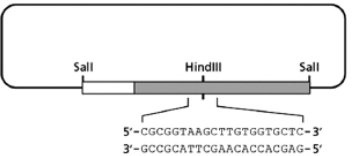You have created a piece of recombinant DNA by placing a cDNA from a gene you believe is important for the differentiation of liver cells (called LC1) onto an expression plasmid that contains all the sequences necessary for propagation of this DNA in bacteria and for the production of the LC1 protein in bacteria.A picture of this plasmid is shown in Figure 10-66A, with the segment of the DNA containing the LC1 gene depicted as a gray rectangle; the promoter sequence is depicted as a white rectangle.The LC1 protein is phosphorylated on serine 54; the nucleotide sequence of the portion of the DNA that encodes this region is shown below the diagram.All HindIII and SalI restriction sites have also been mapped on the plasmid; the recognition sequences for these restriction nucleases are shown in Figure 10-66B.
Table 10-56 (A)
(B)
Figure 10-66
A.Given the information above, write out the amino acids 52 to 57, encoded by the nucleotide sequence shown above.Be sure to number the amino acids appropriately.(Hint: Remember, serine is amino acid number 54.)
B.You want to create a mutant version of the LC1 gene that replaces the serine 54 found on this peptide with a glycine.You want to do this by changing only one nucleotide, and you also want to destroy the HindIII recognition sequence with this change.Write out a 21-nucleotide DNA sequence that can accommodate these changes.Be sure to (i) write out the DNA and label the 5′ and 3′ ends, (ii) underline the mutated HindIII recognition site, and (iii) circle any change made to the original sequence.
Definitions:
Agency Law
The legal principles governing the relationship between an agent who acts on behalf of another person or entity, known as the principal, and the extent of their legal authority.
Principal-Employer
The primary entity or individual who employs and is responsible for the actions of their workers or agents.
Wrongful Acts
Actions or conduct that are unlawful or infringe upon someone's rights.
MRSxy
The marginal rate of substitution (MRSxy) is the rate at which a consumer is willing to trade off one good (x) for another (y) while maintaining the same level of utility.
Q13: Which of the following statements is FALSE
Q18: You are interested in examining the
Q21: You are trying to identify the peroxisome-targeting
Q36: You have discovered an operon in
Q43: Which of the following statements about iPS
Q48: Which of the following DNA sequences is
Q52: Below is the sequence from the
Q54: Define homeostasis and illustrate your understanding of
Q59: Which of the following methods would be
Q72: Experimental evidence supporting the chemiosmotic hypothesis was